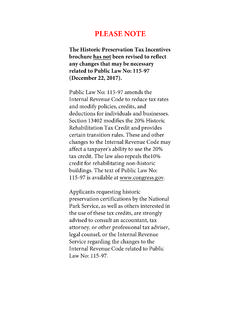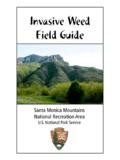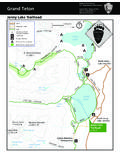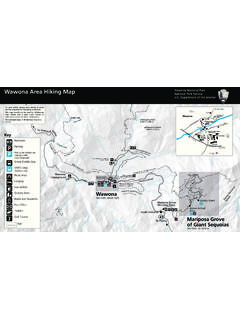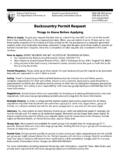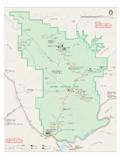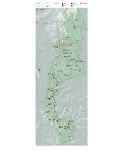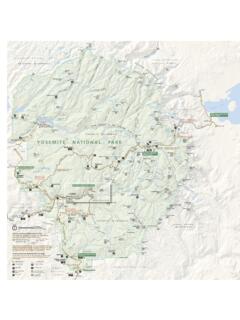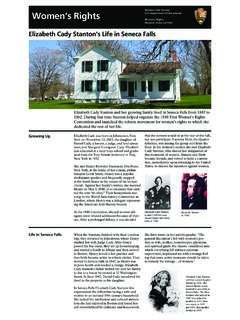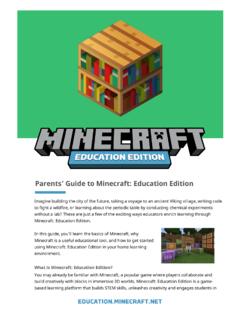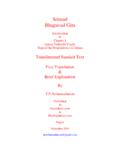Transcription of A Brief History of Chaco Culture National Historical Park
1 A Brief History of Chaco Culture National Historical park 900s BC The first dated evidence of human occupation of Cha co Canyon comes from an archaeological site protect ed by a cliff overhang. This sheltered area protected fragile materials that were able to be dated. Early peoples were likely hunting and gathering throughout the canyon. Human occupation of the canyon likely began much earlier. 200sAD Pithouses, or partially subterranean features with 1-2 rooms begin to appear throughout the canyon. Starting in 500 AD, large pithouse villages containing 20-80 pithouses and features are con structed within the canyon. 700s Small house sites, visible at Casa Rinconada, begin to be constructed. 850-1150 Chaco Canyon served as a major center of ancestral Puebloan Culture . Remarkable for its monu mental buildings, distinctive architecture, astronomy, artistic achievements, it served as a hub of ceremony, trade, and administration for the Four Corners Area unlike anything before or since.
2 1150-1250 People stop constructing Great House sites and begin migrating to other locations. These people become the Pueblo Peoples of New Mexico and the Hopi of Arizo na and many maintain their connections with Chaco today. 1600s By this time, what archaeologists recognize as Navajo settlement patterns begin to appear in the canyon, although evide_nce of Navajo occupation in the larger region is already established. Some oral histories place the Navajo, or Dine, people in Chaco Canyon much earlier. , 1680-17005 The Pueblo Revolt of 1680 briefly unified the Pueblo peoples of New Mexico and their neighbors. However, the Spanish returned in 1692 and re-conquered the area. This forced many of the Pueblo peoples into ex ile. Many of these people sought refuge with the Navajo people in Chaco Canyon and the surrounding area.
3 These people intermarried and ex changed ideas. In the canyon, archeologists discover defensive Navajo sites that reflect this era of conflict. 1774 Don Bernardo de Miera y Pacheco, identified the Cha co Canyon area as "Chaca" on a Spanish map. 1823 Jose Antonio Viscarra, the Spanish Governor of New Mexico, led a military force west of Jemez Pueblo on to Navajo lands. He noted many Chacoan buildings along the route. 1849 The Washington Expedition, a military reconnaissance under the direction of Col Washington passed through Chaco . On that expedition Lt. James Simpson, of the Army Corps of Topographical Engineers, surveyed Navajo lands and wrote reports of the Chacoan sites while the Kern brothers drew illustrations of the buildings. 1877 William Henry Jackson, with the US Geological and Ge ographical Survey, produced expanded descriptions and maps of Chacoan sites, in addition to identifying additional structures including a stairway in the cliffs.
4 Jackson took photos of these sites, but none turned out as he experiment ed with a new photographic process that failed. 1888 Victor and Cosmos Mindeleff of the Bureau of Ameri can Ethnology spent several weeks surveying and photographing the major Chacoan sites. Their photographs document early vandalism and looting which now help the park determine the modern effects of visitation, natural processes, and vandalism to the sites. 1896-1900 After excavating Mesa Verde cliff dwellings and other ancestral Puebloan sites, Richard Wetherill petitioned to excavate the sites at Chaco . The Hyde Exploring Expedition was formed. Led by George H. Pepper from the American Museum of Natural History in New York City, funded by the Hyde family, and led by Richard Wetherill, the Expedition established large excavations at Pueblo Bo nito.
5 The focus of the expedition was the accumulation of artifacts for the museum collection and thus numerous crates of artifacts were shipped to the American Museum of Natural History in New York. The excavation was a large undertaking with many local workers. In order to supply these workers and turn a profit the expedition built several trading posts. 1901 Samuel Joseph Holsinger, directed by the Commissioner of the General Land Office, came to Chaco to investigate the Hyde Exploring Expedition. He spent weeks compiling an 80 page re port with over 125 photographs of Chaco Canyon. He recommended the creation of a National park to protect the archeological sites. The investigation halted work in progress with the Hyde Exploring Expedition. In the same year, Richard Wetherill filed a homestead claim on land that included Pueblo Bonito, Chetro Ketl, and Pueblo del Arroyo.
6 The claim was granted in 1910 after Wetherill's death. 1902 Edgar L. Hewett of the School of American Research, Museum of New Mexico, and University of New Mexico mapped many Chacoan sites. 1906 The Federal Antiquities Act was passed with the help of Hewett and many others. This was the first federal legislation to protect archeological sites . 1907 Chaco Canyon National Monument was established on March 11, 1907 by Theodore Roosevelt. The monument was administered by the General Land Office until the establishment of the Na tional park Service in 1916 and was monitored through inspections and by canyon resi dents. 1910 Having been prohibited from further excavation, Rich ard Wetherill continued to ranch in Chaco Canyon. In 1910, Richard Wetherill was murdered by Chiishchi'ilin Begay.
7 Wetherill is buried in a small cemetery west of Pueblo Bonito. 1920 Hewett returned to Chaco to excavate Chetro Ketl, but his expedition was short-lived. 1921-1927 Neil Judd, of the Smithsonian Institution and spon sored by the National Geographic Society, excavated several hundred rooms at Pueblo Bonito, as well as portions of Pueblo del Arroyo and several smaller sites. Artifacts from the expedition were sent to the Smithsonian Institution. Neil Judd also worked to preserve the exca vated portions of the building by repairing walls and replacing door lintels. He believed the great houses were large apartment complexes. 1923 A. C. Griffin was appointed the first part-time custodian of the park . He came to the canyon in 1921 to run the trading post and continued to live in the park until 1936, after his official work ended in 1928.
8 1927 Frank H. H. Roberts excavated the pithouse village, Shabik' eschee. One of the few excavations of pithouse villages, this site became the archeological "type-site" or example for such sites. 1928-29 Dr. A. E. Douglas of the University of Arizona applied the new method of tree-ring dating, or den drochronology, to Pueblo Bonito and many other sites in Chaco Canyon for the National Geographic Society. 1929-49 Hewett and Donald D. Brand of the University of New Mexico directed field schools at Chetro Ketl, Casa Rin conada and other sites. Many of the students on those field schools became Chacoan schol ars or future employees of the park Service. 1937 Gordon Vivian began a long career with the park . Throughout his tenure he worked to preserve many sites including Pueblo Bonito, Chetro Ketl, and Casa Rinconada, setting NPS standards in ruins stabilization in the Southwest.
9 1937-1942 A local division of the Civilian Conservation Corps, or CCC, designed to put people to work during the Great Depression, was established at Chaco . Comprised of local Navajo men, the Mobile Unit worked to repair, stabilize and protect portions of 6 sites in the canyon. The program's success led to the establishment of permanent Ruins Stabilization Units in many other parks including Chaco . 1939-1941 A general CCC camp known as CCC Camp NP-2-N was established at Chaco . The camp's nearly 1000 young men who worked at the park over 3 years created erosion control by planting thousands of trees and shrubs and creating berms, developing infrastruc tur~, and constructing roads. 1941 On January 21, 1941 Threatening Rock, a large boulder behind Pueblo Bonito, fell and crushed 30-60 rooms at Pueblo Bonito.
10 1947 Tomasito, the last Navajo resident living in Chaco Can yon, was removed from the Monument. Monument boundaries were fenced to exclude livestock grazing. 1949 The University of New Mexico deeded state-owned lands in Chaco Canyon National Monument o the National park Service, in exchange for continued rights to conduct scientific research in the area. 1959 A new park visitor center was dedicated in its current location, replacing an old building on the west end of the canyon. Staff housing and campgrounds were also built as part of the National park Service "Mission 66" construction boom from 1956-1966, 1971 Jonathon Raymon proposed that a corner door at Pueblo Bonito marked the winter solstice. This launched the study of archaeoastronomy which attempts to understand the astronomical practices of ancient peoples.
